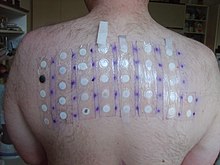Bergamot oil
Bergamot oil is the essential oil from the fruits of bergamot . It is obtained by pressing the bergamot from their peels in southern Italy ( Calabria ). In the past, pressing was done by hand, then with self-made pressing devices made of wood, today it is done by machine. In order to obtain one liter of oil, 200 kilograms of fruit have to be pressed.
properties
| safety instructions | |||||||
|---|---|---|---|---|---|---|---|
| Surname |
Bergamot oil |
||||||
| CAS number |
8007-75-8 |
||||||
|
|||||||
Bergamot oil is a green to dark brown clear liquid. The density is 0.877 g · cm −3 (25 ° C), the boiling point is 159 ° C and the refractive index is given as 1.4665 (20 ° C).
composition
It is a mixture of substances and consists of a few dozen different compounds ( terpenes and other hydrocarbons ) that vary depending on the cultivation, study and type of extraction.
The main components are limonene (23–55%), linalyl acetate (15–41%), linalool (1.6–24.2%), γ-terpinene (1.1–12.6%), β-pinene (2, 9 to 10.6%), α-pinene (0.7-1.9%), sabinene (0.5-1.7%), myrcene (0.4-2.3%), δ- 3- Caren (0.01-2.0%), β-bisabolene (0.1-1.3%), geraniol (0.0 to 5.7%), α- terpineol (0.1 to 3.1% ), Geranyl acetate (0.1-1.9%), nerylacetate (0.0-1.6%), geranial (0.0-1.2%), p- cymene (0.0-3.6% ).
use
Use as a perfume raw material
Bergamot oil was introduced between 1672 and 1708, according to Gildemeister and Hoffmann, "The essential oils". Bergamot purchases from 1714 can be found in the books of the Eau de Cologne and perfumery factory Johann Maria Farina opposite Jülichs-Platz in Cologne (“Farina opposite” for short).
Since it was mentioned in 1750, when the bergamot was planted by a certain Nicolo Parisi, bergamot oil has been an essential raw material for the perfume industry and gives cologne in particular its typical odor.
The scent is clear, fresh, lively, tangy and of great originality. It is included as a top note in practically all perfumes and is mainly used in eau de colognes and fresh, lemony eau de toilettes .
Use as a food
Bergamot oil is used to flavor Earl Gray and Lady Gray tea ; it is also found in a special kind of Turkish Akide sweets and in French sweets from Nancy ; It is also used to flavor pipe and snuff tobacco.
Other uses
Bergamot oil is heavily diluted with olive oil and used as a tanning accelerator. Due to toxicological considerations, this application is not recommended in order to prevent damage to the skin.
toxicology
In studies on patch tests with substances containing bergamot oil, it has been shown that after exposure to ultraviolet light this has the phototoxic effect of increasing the reddening of the skin. The furocoumarins contained in bergamot , e.g. B. bergapten (5-methoxypsoralen, contained up to 1%), possibly also citropten , 6 ', 7'-dihydroxybergamottine and bergamottine also the 0.25-0.5 % citral contained is possible for the phototoxicity. This property is also found in many other citrus fruits .
Bergapten has also been linked to inhibition of the potassium channel ; In one case study, a patient who drank 4 liters of Earl Gray tea per day suffered from paresthesia , fasciculation and muscle cramps.
literature
- Giovanni Dugo, Ivana Bonaccorsi (eds.): Citrus bergamia. Bergamot and Its Derivatives. Production, Processing, Food, and Medicinal Values (R. Hardman (series ed.): Medicinal and Aromatic Plants - Industrial Profiles, Vol. 51), CRC Press - Taylor & Francis, Boca Raton u. a. 2014, ISBN 978-1-4398-6227-8
- Francesco Gionfriddo e Domenico Castaldo: Ridefinizione dei parametri analico-composizionali dell'olio essenziale di bergamotto estratto a freddo / Ridefinition of analytical compositional parameters for "cold pressed" bergamot essential oil . In: Essenze Derivati Agrumari . No. 74, 2004, pp. 151-152.
- ISO 3520: 1998 Oil of bergamot [Citrus aurantium L. subsp. bergamia (Wight et Arnott) Engler], Italian type ISO / TC 54 Essential oils
- Carlo Mangiola, Enrico Postorino, Francesco Gionfriddo, Maurizio Catalfamo, Renato Manganaro and Giuseppe Calabrò: Evaluation of the Genuineness of Cold-pressed Bergamot Oil . In: Perfumer & Flavorist . October 2009, pp. 26–31.
Web links
Individual evidence
- ↑ a b Andreas Lüneberg: Essential oils and fragrances - natural remedies . Reinhard Welz Vermittler Verlag eK, 2004, ISBN 3-937636-81-1 , p. 87 ( limited preview in Google Book search).
- ↑ a b c d data sheet Bergamot oil, Italy origin at Sigma-Aldrich , accessed on March 13, 2014 ( PDF ).
- ↑ Giovanni Dugo, Luigi Mondello: Citrus Oils: Composition, Advanced Analytical Techniques, Contaminants, and… CRC Press, 2010, ISBN 1-4398-0029-4 , p. 90 ( limited preview in Google Book search).
- ↑ Peter Rohrsen: The tea: cultivation, varieties, history . CH Beck, 2013, ISBN 3-406-65418-5 , pp. 41 ( limited preview in Google Book search).
- ↑ Entry on bergamot oil. In: Römpp Online . Georg Thieme Verlag, accessed on March 12, 2018.
- ↑ Nicole Raquet: In vitro studies on the relative phototoxic and phototoxic potential of naturally occurring furocoumarins and limettin. Dissertation. 2011. urn : nbn: de: hbz: 386-kluedo-26443
- ↑ Entry on bergamot oil. In: Römpp Online . Georg Thieme Verlag, accessed on March 12, 2018.
- ↑ Girard J, Unkovic J, Delahayes J, Lafille C: Phototoxicity of Bergamot oil.Comparison between humans and guinea pigs . In: Dermatologica . 158, No. 4, 1979, pp. 229-43. doi : 10.1159 / 000250763 . PMID 428611 .
- ↑ Kejlova K, Jirova D, Bendova H, Kandarova H, Weidenhoffer Z, Kolarova H, Liebsch M: Phototoxicity of bergamot oil assessed by in vitro techniques in combination with human patch tests . In: Toxicology in Vitro . 21, No. 7, 2007, pp. 1298-1303. doi : 10.1016 / j.tiv.2007.05.016 . PMID 17669618 .
- ^ J Finsterer: Earl Gray tea intoxication . In: Lancet . 359, No. 9316, 2002, p. 1484. doi : 10.1016 / S0140-6736 (02) 08436-2 . PMID 11988248 .


